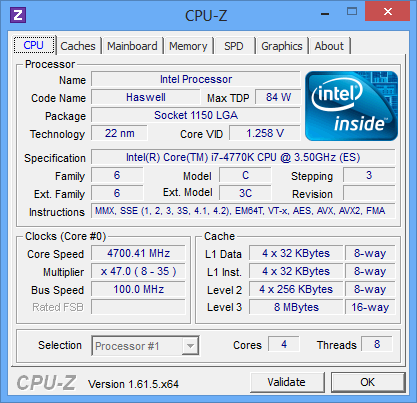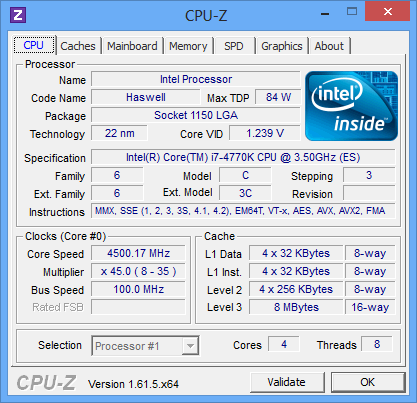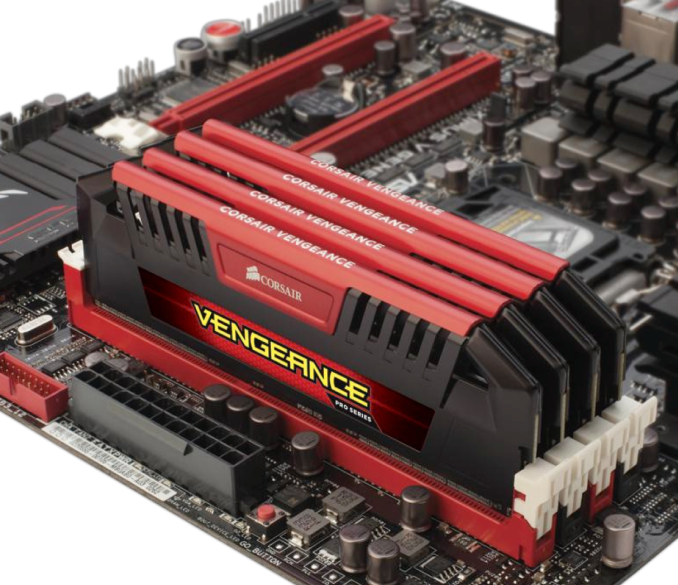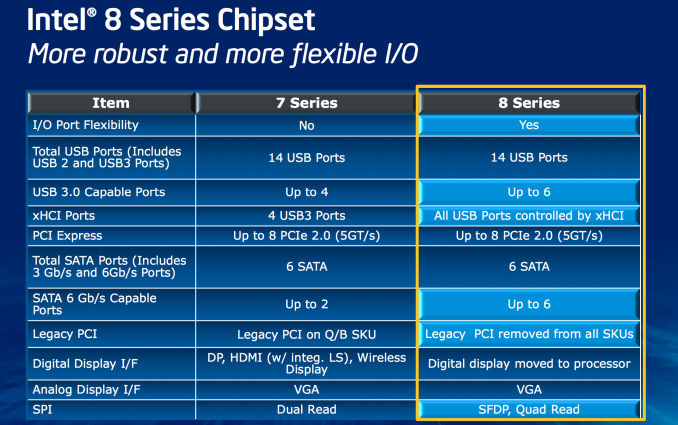The Haswell Review: Intel Core i7-4770K & i5-4670K Tested
by Anand Lal Shimpi on June 1, 2013 10:00 AM ESTMemory
Haswell got an updated memory controller that’s supposed to do a great job of running at very high frequencies. Corsair was kind enough to send over some of its Vengeance Pro memory with factory DDR3-2400 XMP profiles. I have to say, the experience was quite possibly the simplest memory overclocking I’ve ever encountered. Ivy Bridge was pretty decent at higher speeds, but Haswell is a different beast entirely.
Although I used DDR3-2400 for most of my testing, Corsair’s Vengeance Pro line is available in frequencies rated all the way up to 2933MHz.
Platform
Haswell features a new socket (LGA-1150). Fundamental changes to power delivery made it impossible to maintain backwards compatibility with existing LGA-1155 sockets. Alongside the new socket comes Intel’s new 8-series chipsets.
At a high level the 8-series chipsets bring support for up to six SATA 6Gbps and USB 3.0. It’s taken Intel far too long to move beyond two 6Gbps SATA ports, so this is a welcome change. With 8-series Intel also finally got rid of legacy PCI support.
Overclocking
Despite most of the voltage regulation being moved on-package, motherboards still expose all of the same voltage controls that you’re used to from previous platforms. Haswell’s FIVR does increase the thermal footprint of the chip itself, which is why TDPs went up from 77W to 84W at the high-end for LGA-1150 SKUs. Combine higher temperatures under the heatspreader with a more mobile focused chip design, and overclocking is going to depend on yield and luck of the draw more than it has in the past.
Haswell doesn’t change the overclocking limits put in place with Sandy Bridge. All CPUs are frequency locked, however K-series parts ship fully unlocked. A new addition is the ability to adjust BCLK to one of three pre-defined straps (100/125/167MHz). The BCLK adjustment gives you a little more flexibility when overclocking, but you still need a K-SKU to take advantage of the options.


In terms of overclocking success on standard air cooling you should expect anywhere from 4.3GHz - 4.7GHz at somewhere in the 1.2 - 1.35V range. At the higher end of that spectrum you need to be sure to invest in a good cooler as you’re more likely to bump into thermal limits if you’re running on stable settings.

















210 Comments
View All Comments
chizow - Saturday, June 1, 2013 - link
Nice review Anand, it's pretty much what I expected from Haswell. 5-15% over IVB with all the bells and whistles of Lynx Point Z87 (6xSATA6G, more USB 3.0 etc.) This will make a nice upgrade for me coming from an OC'd i7-920 and X58 platform, now to see what deals MicroCenter has on the 4770K.I would have liked to have seen normalized clockspeed comparisons in the 5-gen Intel round-up but understand this does not reflect real-world results, given SB and above have much better turbo boost and base clocks. I think it would've given a better idea of IPC however, for those who have been overclocking their older platforms to similar max OC levels.
I also would have liked to have seen more gaming and OC'ing tests but understand this first review needed to cover most of the bases for a general audience, look forward to more testing in the future along with some looks at the Z87 chipset nuances.
Concillian - Saturday, June 1, 2013 - link
So what I'm seeing is 4770 compared with 3770... ~13% more power at load for Hasswell, but less than 10% more performance in the benchmarks? Is that correct?A5 - Saturday, June 1, 2013 - link
Anand's numbers put it at 13% faster with an 11% power increase. Not sure how you did the math.Concillian - Saturday, June 1, 2013 - link
You're right in that particular test. +12% power for +13% performance. Still disappointing. Most of the other benchmarks are showing less than 10% improvement, but we don't know the power story. Overall disappointing. With all the talk about power efficiency, I was hoping for +5-10% performance at the same or lower power consumption. All the power benefits seem to be at idle.gipper51 - Saturday, June 1, 2013 - link
I'm glad I went ahead and built my 3770 system a few months ago instead of holding out for Haswell. Nothing about Haswell was worth waiting for (for my needs). Damn...based on this and Intel's roadmaps I may be on IVB for a looooong time.LordSegan - Saturday, June 1, 2013 - link
Very weak new chip. Minimal increase in performance unless you are running a render farm or using a crappy ultra book. Useless for desktop gamers.vlvh - Saturday, June 1, 2013 - link
I'm just wondering what the rationalisation for using a Core 2 Duo for comparison benching is? Surely a Core 2 Quad (eg Q6600) would be a more accurate representation seeing as all the other parts in the benchmark are quad core.WhoBeDaPlaya - Saturday, June 1, 2013 - link
You'd think Anand would have covered something as important as this.I did not see this in _any_ of the reviews.
Also, the wording on the BCLK overclocking is a little odd. So bottom line - can we OC the 4770 using BCLK or not?
Kevin G - Monday, June 3, 2013 - link
The actual BLCK changes will be pretty much inline with what you'd be able to do on Z68 or Z77, about 110 Mhz max.Socket 1150 and Z87 add another bus multiplier to feed the CPU like socket 2011 parts have. So you can have a 100 Mhz clock feeding the PCI-E controller with a 1.25x multiplier a 125 Mhz clock will feed the CPU cores before the CPU multiplier. Increasing the BCLK to 108 Mhz and a 1.25 bus multiplier would equate to a 135 Mhz clock before the CPU multiplier is applied.
jmcb - Saturday, June 1, 2013 - link
All this means is when I finally get my first quad core PC, a 3770k will be cheaper. I see no reason to get this over that.